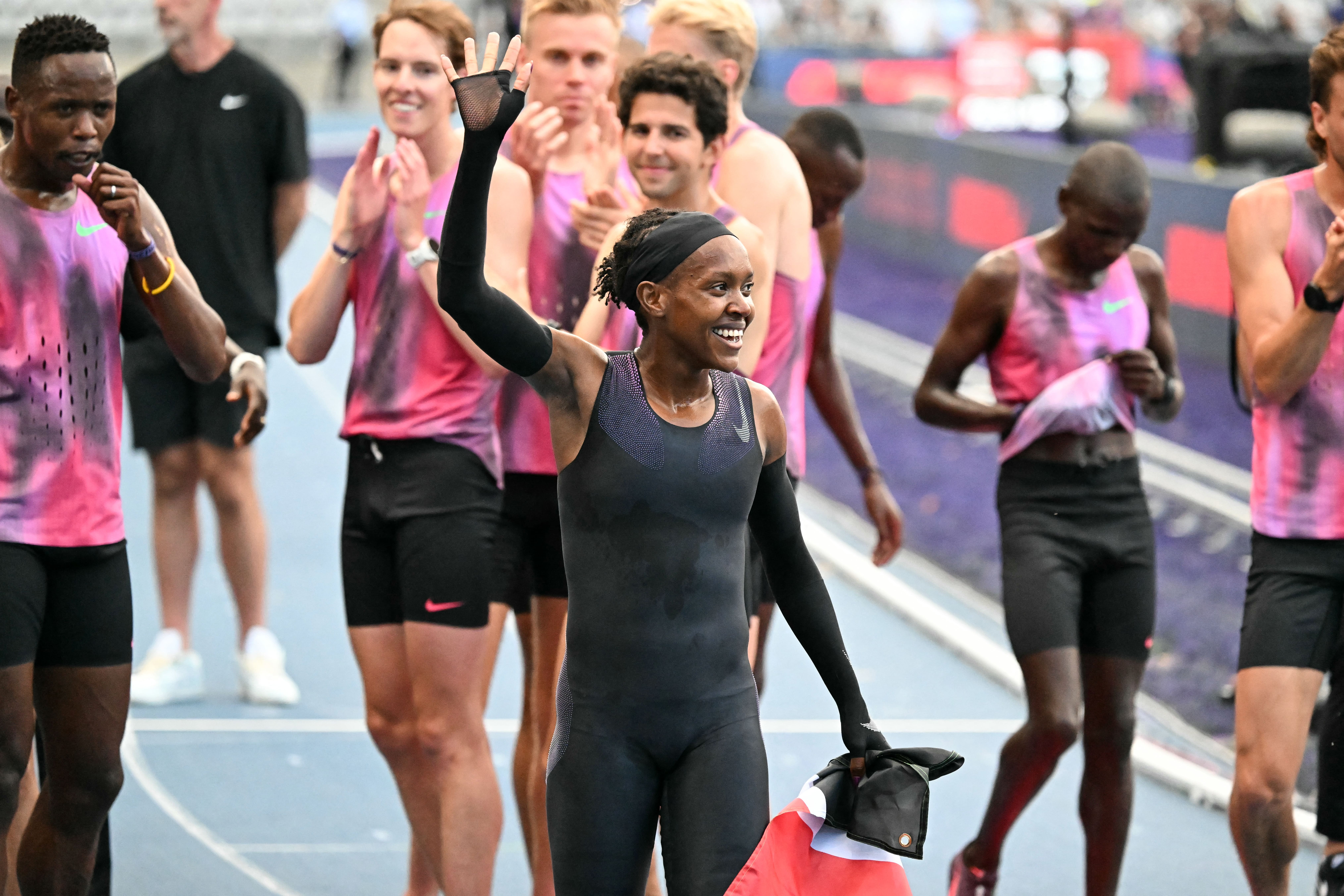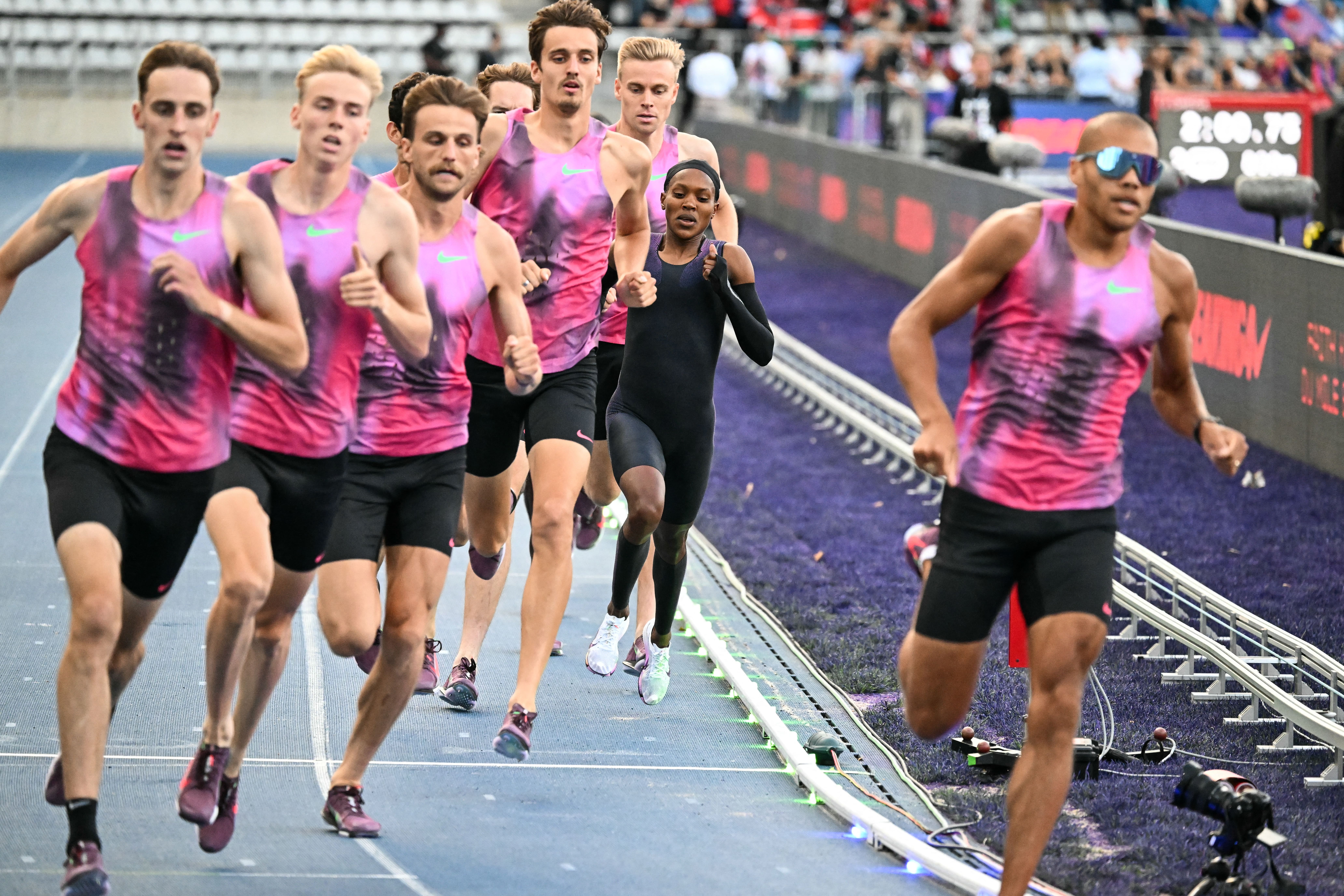The World’s Fastest Woman Didn’t Break the 4-Minute Mile. She Still Made History
In a superhero-worthy suit and under a global spotlight, Faith Kipyegon pushed her limits and reminded the world what women can do.


For any elite athlete, chasing the outer edges of your own potential is an act of courage. But on June 26, Faith Kipyegon—a Kenyan three-time Olympic gold medalist in the 1500 meters, world record holder in the women’s mile, and mother—took that pursuit to a new level. Under the bright lights of Paris’ Stade Charléty, she attempted something no woman has ever done: to run a mile in under four minutes.
Spoiler: She didn’t quite get there. But Kipyegon’s time—4:06.42—was still the fastest mile ever run by a woman, shaving 1.22 seconds off her previous best. And while the four-minute goal remains elusive, her Breaking4 attempt was a landmark—both for the sport and for what women are told to believe is possible.
“I think I've shown other women out there that we have to push ourselves,” she told Marie Claire after coming up short on the goal. “You can try.”
Nike, her sponsor, staged the attempt with great attention to detail, curating a mass marketing frenzy to uplift Kipyegon’s charge into the history books. On the ground, the event—which was open to the public—included a luxe purple carpet, the athlete’s favorite color. The stadium’s infield was transformed into a massive broadcasting hub for a livestream featuring Saturday Night Live’s Ego Nwodim as a trackside correspondent.
The brand also created a custom collection in honor of the event for all 13 professional pacemakers—11 men and two women, including Olympians Jemma Reekie and Georgia Hunter Bell. But arguably the most exciting part of the event was how Kipyegon’s bold attempt to do the unprecedented pushed Nike to debut new gear designed to help women test their limits, starting with hers.
Kipyegon wore Nike’s first-ever 3D-printed sports bra in competition, made from FlyWeb, a 3D-printed thermoplastic polyurethane material, which is lightweight enough to make you question if you’re wearing anything at all (I know, I held it). Better at minimizing sweat retention than other textiles, it’s the first 3D-printed bra the brand’s ever made, worn for the first time in competition by Kipyegon during the attempt. The team at Nike says that this—in addition to the other items she wore for the attempt—could eventually be for sale, but no release date has been announced.
Then there was her Fly Suit, a sleek one-piece with a complementary headband and arm and leg sleeves created to help Kipyegon be as aerodynamic as possible, which looked like something pulled straight from The Incredibles. The suit featured strategically placed Aeronodes, half spheres that vary in size—some smaller than a pencil tip. Their purpose is two-fold: Split the air in front of Kipyegon and reduce drag. Kipyegon completed the look with a revolutionized track spike that’s about 25 percent lighter than the Victory 2 model she wore at last year’s Games at 85 grams, and you’ve got a well-tested recipe designed for maximum effectiveness and speed.
Get exclusive access to fashion and beauty trends, hot-off-the-press celebrity news, and more.
“It's a career highlight for me, for sure,” says Amy Jones Vateralus, Vice President, Nike Sports Research Lab (NSRL), who had a heavy hand in working on these pieces. “To be able to focus on a single athlete, a female athlete, has been really important. Especially since a big part of my career has been advancing women's sport and performance to be able to do that and give it this much commitment.”
That same level of precision extended far beyond the clothing. From the get-go, scientists deemed Kipyegon’s attempt possible, but with a slew of caveats that Nike obsessed over meticulously in the planning of Breaking4. Elements like gaming the weather (organizers sought a window with zero rain, wind speeds under 12 kilometers per hour, and moderate temperatures), minimizing jet lag (Paris’ time zone is only one hour behind Kipyegon’s home in Kenya), and the perfect pacer strategy to keep her on pace and shield her from the wind.

Faith Kipyegon mid-stride at the "Breaking4" event in Paris on June 26.
The significance of this moment, as breathtaking as it was under the bright Paris lights, extended far beyond the track and a new record. For decades, the four-minute mile has been a benchmark for human speed, first broken by a man in 1954 by Britain’s Roger Bannister. That same month, England’s Diane Leather became the first woman to break the five-minute mile. Since 1967, only 15 new records have been set in the women’s mile. Thirteen of those came before the year 2000. In 2023, Kipyegon ran a 4:07.64, smashing the old record by 5 seconds—and in doing so, set the stage for what would become Breaking4.
Even if she didn’t break the barrier, Kipyegon brought unprecedented attention to women’s middle-distance running. While we’ve seen an overall uptick in fanfare of women’s sports (about 3 in 10 U.S. adults now follow women’s professional or college sports “extremely,” “very” or “somewhat” closely, according to an AP poll)—track and field has suffered from a lack of media coverage for a long time. Regardless of what happened in the stadium on Thursday, Kipyegon’s boldness brought unprecedented attention to middle-distance running, an achievement that carried even more weight coming from a woman.
Her attempt also reframed the conversation about what women’s bodies are capable of achieving. It was a reminder to so many that if you dare to dream, you have the opportunity to surprise yourself well beyond the parameters of sport.
“I wanted to prove to the world that everything is possible in life, but only if you dare to try,” Kipyegon said in a post-race press conference.
“If it’s not me, it will be somebody else. I know one day, one time, a woman will run under four minutes. I will not lose hope.”
Faith Kipyegon
If you dare to try, you might also be rewarded in ways that you don’t expect. The morning after the attempt, Tanya Hvizdak, Vice President of Global Sports Marketing at Nike, announced the brand’s commitment to building a maternity ward in Kipyegon’s honor. Located in Keinget Ward, Kuresoi South Sub County, Nakuru County, the new Dare To Dream Maternity Ward represents a lifeline in a country where an estimated 7,700 women die each year from pregnancy-related complications.
“To see this, it’s really emotional,” said Kipyegon, who like many athletes, had a difficult journey back to sport after having her daughter Alyn by caesarean section in June 2018. “It will help so many mothers who have already carried their babies for nine months, get to hold them in their hands.”
This initiative perfectly encapsulated Faith’s spirit. Her physical prowess, records, and gold medals are undeniable, but her true legacy extends well beyond the track as an advocate for maternal and girls’ health.
“I feel great. I feel so proud of myself that I've tried. Today was a learning lesson—I gave it my all,” she told Marie Claire. “Everything is possible. I think there's more in the tank. I can still improve on what I did today, and I'm so grateful.”
More in the tank, indeed. Next weekend Kipyegon will lace up again at the Prefontaine Classic in Eugene, Oregon. She’s planning to go all-in and gun for a new world record in the 1500-meter, she told reporters Friday morning.
And don’t worry, she’s not done yet with the mile.
“If it’s not me, it will be somebody else. I know one day, one time, a woman will run under four [minutes]. I will not lose hope. I will still go for it.”
Emily Abbate is a Brooklyn-based, veteran journalist on a mission to empower women to live healthier, happier, and more-motivated lives. Now a 13-time marathoner and triathlete, the certified wellness coach and former fitness editor at SELF is the brains behind the podcast Hurdle, acclaimed by The New York Times as “addictive,” cusping 10 million downloads with listeners in more than 220 countries. You can find her most recent bylines in GQ, Women’s Health, and Marie Claire.
